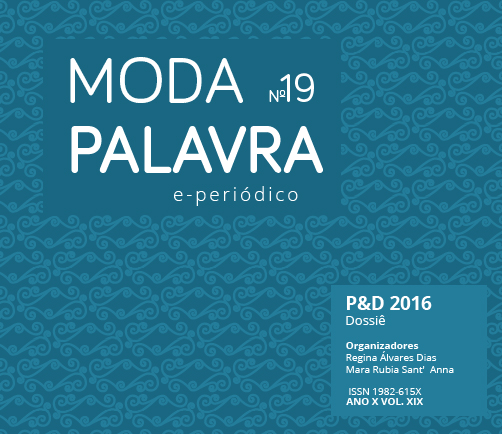Fashion and death: Trends Cycles
DOI:
https://doi.org/10.5965/1982615x10192017098Keywords:
fashion, profanation, cycleAbstract
Fashion is composed of cycles subpostostrends that seek to eliminate the past for a new one, which makes it ephemeral and eternal at the same time. This study investigates how is the relationship between these cycles of trends over time, through a brief history of fashion, considering the theoretical rules of Simmel, Crane and Caldas. They will still be used concepts proposed by Agamben, such as: device, in order to classify the system of the fashion; contemporaneidade, to understand the action of that factor in relation to the time and profanation, to identify the capacity to maintain in the society. It is ended that the fashion, as well as the death, renews the society, it destroys and it creates the new, as a system naturalized artificially.
Downloads
References
AGAMBEN, Giorgio. Profanações. São Paulo: Boitempo, 2007.
AGAMBEN, Giorgio. O que é contemporâneo? E outros ensaios.Chapecó: Editora Argos, 2009.
AGAMBEN, Giorgio.A comunidade que vem.São Paulo: Boitempo, 2013.
BLACK, Sandy. Eco-chic: the fashion paradox. London, UK: Black Dog Publishing, 2008.
BURKE, Peter.Testemunha ocular: história e imagem. São Paulo: Edusc, 2004.
CALDAS, Dario. De trendsetters, modas e mídias: breve ensaio sobre a banalização do conceito de tendência na cultura contemporânea.In: COLÓQUIO BRASIL-FRANÇA DE CIÊNCIAS DA COMUNICAÇÃO E DA INFORMAÇÃO, 7., 2004, Porto Alegre. Anais... São Paulo: Intercom, 2004.
CRANE, Diana. A moda e seu papel social: classe, gênero e identidade das roupas.São Paulo: Editora Senac, 2006.
CRANE, Diana. Ensaios sobre moda, arte e globalização cultural.São Paulo: Editora Senac, 2011.
HOLZMEISTER, Silvana. O estranho na Moda: imagem nos anos 1990.São Paulo: Estação Letras e Cores, 2010.
LEOPARDI, Giacomo. Diálogo della Moda e della Morte. In.: Operette Morali. Milano: Rizzoli Editore, 1951. p. 29-33.
LIPOVETSKY, Gilles. O Império do Efêmero: a moda e seu destino nas sociedades modernas.São Paulo: Companhia das Letras, 2009.
LIVNI, Ana; SCUDER, Fernando. Manifiesto MODA lenta SLOW fashion.Disponível em: <http://analivni.com/MODAlenta/filosofia.html>. Acesso em: 01 ago.2016.
MESQUITA, Cristiane. Moda contemporânea: quatro ou cinco conexões possíveis. São Paulo: Editora Anhembi Morumbi, 2007.
OBI, Michele. I’m not a plastic bag!. 20 de março de 2007.Disponível em: <http://www.myfashionlife.com/archives/2007/03/20/im-not-a-plastic-bag/>. Acesso em: 01 ago. 2016.
OLIVEIRA, Jorge Marcelo. Semanas de Moda –Primavera/Verão 2011 –Alta Costura –Jean Paul Gaultier. 27 de janeiro de 2011. Disponível em: <https://mondomoda.com.br/2011/01/27/couture-spring-2011-gaultier/>. Acesso em: ago. 2016.
REDIGBE, Dick. Subcultureand style. In: REDIGBE, Dick. The Meaning of Style. Methuen & Co. Ltd, 1979. p. 1-4.
SAWYER, Donald. Economia Verde e/ou Desenvolvimento Sustentável?. Revista ECO21, v. 177, n. 8, p. 36-42, 2011. Disponível em: <http://www.eco21.com.br/textos/textos.asp?ID=2507>. Acesso em: 01 ago. 2016.
SVENDSEN, Lars. Moda: uma filosofia. Rio de Janeiro: Zahar, 2010.
SILVA, Orlando Roque; VENANZI, Délvio; PAIXÃO, Marisa Regina. Estratégias de cadeias de suprimentos para o setor de vestuário-moda: uma análise das empresas Zara e H&M. In: SIMPÓSIO DE ADMINISTRAÇÃO DA PRODUÇÃO, LOGÍSTICA E OPERAÇÕES INTERNACIONAIS, 14., 2011, São Paulo. Anais... São Paulo: FGV-EAESP, 2011.
SIMMEL, George. A filosofia da Moda.Lisboa: Edições Texto e Grafia Ltda., 2014.
THE AGED P. How sweet... BBC goes all nostalgic over the punks saying “Stuff The Jubilee” in 1977. Disponível em: <http://www.theagedp.com/?tag=punks>. Acessoem: 01 ago. 2016.
VESTOJ. Myth-making in the fashion magazine. Disponível em: <http://vestoj.com/stephane-mallarmes-la-derniere-mode-and-myth-making-in-the-fashion-magazine/>. Acesso em: 01 ago. 2016.
VILLAÇA, Nízia. Corpo à moda mídia na cidade do Rio de Janeiro.Projeto de pesquisa Construção do corpo na mídia: texto e imagem. Pós-Eco/UFRJ, 2008.
Downloads
Published
How to Cite
Issue
Section
License
Copyright (c) 2016 Flavia Jakemiu Araujo Bortolon

This work is licensed under a Creative Commons Attribution-NonCommercial 4.0 International License.
When submitting an article for publication in ModaPalavra e-periodico, the author (s) agree (s) with the following terms:
- Authors maintain the copyright in their manuscripts and grant the journal the right of first publication, with work simultaneously licensed under the Creative Commons Attribution-NonCommercial 4.0 International, which allows sharing the work with the acknowledgment of authorship and the initial publication in the journal without payment ;
- Authors may use the same results in other publications after the first publication, provided that they indicate ModaPalavra e-journal as the original publication medium;
- Authors are authorized to take additional contracts, separately, only after the original publication in ModaPalavra e-journal, provided they indicate ModaPalavra e-journal as the original publication medium;
- Authors are allowed and encouraged to publish and distribute their work online (eg in institutional repositories or on their personal page), only after the editorial process and the first publication, provided they indicate ModaPalavra e-journal as the original publication medium;
- To indicate ModaPalavra e-journal as the original publication medium, authors should use the following text template: "This article was originally published by ModaPalavra e-periodical, under a CC BY NC license, in its volume [insert volume] number [insert number] in the year of [insert year], and can be accessed at: http://www.revistas.udesc.br/index.php/modapalavra/ ";
- The opinions expressed in the articles are the author’s sole responsibility, not necessarily reflecting the journal’s opinion. The publication of any material that is owned and held in copyright by a third party, including – but not limited to - articles, photos or drawings was previously authorized by their representatives to be published in ModaPalavra e-journal.









